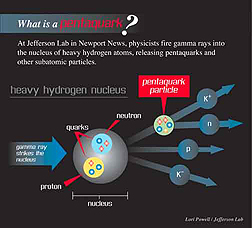Research
Highlights...
|
 |
| Number 141 |
September 15, 2003 |
|
Developing inspection methods for ceramics
DOE's Argonne National Laboratory
is collaborating with NASA to develop a method of inspecting the
leading-edge thermal protection system for space shuttle wings.
Researchers want to define methods to eliminate or significantly
reduce the chance for reoccurrence. NASA researchers suspect that
the impact of a piece of foam insulation broken off during liftoff
may have damaged one of the ceramic composite panels that protect
the wing's leading edge. "NASA invited us to work on this very
short-term effort because we have been funded by DOE for 20 years
to work on inspection methods for ceramics," said Argonne engineer
Bill Ellingson. "We have the knowledge base for developing inspection
methods for ceramics at high temperatures."
[Catherine Foster, 630/252-5580;
cfoster@anl.gov]
|
|
Smoking zaps enzyme
in peripheral organs
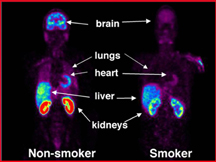 |
|
Whole
body PET scans showing the distribution of radiolabeled
monamine oxidase in one of the nonsmokers and one of the
smokers. Red is the highest radiotracer concentration; purple
is the lowest. Images are scaled so that they can be compared
directly.
|
Researchers at DOE's Brookhaven
National Laboratory, who previously found reduced levels of
monoamine
oxidase B (MAO B) in smokers' brains, now provide compelling
evidence from whole-body positron emission tomography (PET)
scans that MAO B in the kidneys, heart, lungs and spleen is also
reduced
by smoking. The implications of the findings need to be examined
in greater detail, the scientists say. One role of the enzyme
is to break down chemical compounds that elevate blood pressure,
such as certain chemicals in cheese and wine as well as some chemicals
released by nicotine. Thus, any health consequences of reduced
MAO B may be indirect and associated with other factors.
[Karen
McNulty Walsh, 631/344-8350;
kmcnulty@bnl.gov]
|
|
Tevatron exceeds luminosity
goal for the year
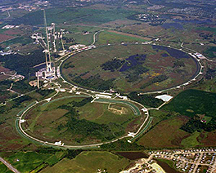 |
| Fermilab's
four-mile Tevatron has exceeded its luminosity goal. |
On August 22 the integrated luminosity at the Tevatron
exceeded 225 inverse picobarns—the luminosity goal for the
entire fiscal year at the DOE's Fermilab.
Peter Garbincius, the Beams Division deputy head, was pleased with
the achievement at the world's highest-energy particle accelerator,
coming more than a month before the finish of the fiscal year. "Everyone
in the Beams Division and the laboratory has worked very hard to
achieve this goal," he said. Integrated luminosity is a measure
of total particle interactions over a given time. The greater the
luminosity of an accelerator, the greater its chances for discovery.
[Mike
Perricone, 630-840-5678;
mikep@fnal.gov]
|
|
PNNL supercomputer
fastest open system in U.S.
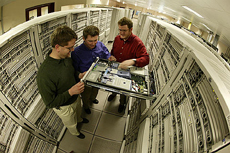 |
| At
the William R. Wiley Environmental Molecular Sciences Laboratory,
this new supercomputer operates 9,200 times faster than a
PC. |
DOE's Pacific Northwest National Laboratory
is now home to the United States' fastest operational unclassified
supercomputer.
The laboratory's 11.8 teraflops industry-standard HP Integrity
system came to full operating power in late August. Based on peak
performance, the PNNL machine is the fifth fastest system in the
world and is the fastest unclassified computer operating in the
U.S. The PNNL system is the world's fastest supercomputer based
on the Linux operating system and is the largest machine ever
built using Intel's 64-bit architecture. The additional power
and speed will enable novel studies in atmospheric chemistry,
climate and subsurface chemistry, systems biology, catalysis and
materials science. The PNNL supercomputer is housed in the Molecular
Science Computing Facility of the William R. Wiley Environmental
Molecular Sciences Laboratory, a DOE scientific user facility
located at PNNL. As such, scientists from around the country can
access the supercomputer for research through a competitive proposal
process.
[Staci
Maloof, 509/372-6313;
staci.maloof@pnl.gov]
|
|
SNS reaches important
milestones
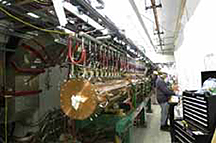 |
|
Drift-tube
linac in the Spallation Neutron Source linear accelerator
tunnel.
|
Researchers at the Spallation Neutron
Source at Oak Ridge National
Laboratory successfully accelerated a beam of negatively charged
hydrogen ions through a drift-tube linac (DTL) accelerator tank
on the first try. The test brought the beam energy up to 7.5 million
electron volts. Tank 1 is the first of six sections of the DTL,
which will be followed by linacs that will accelerate the beam
to 1000 million volts. The DTLs are the responsibility of Los
Alamos National Laboratory—one of six
DOE labs involved in SNS design and construction. The test
is significant because it confirms the performance of the beam
that is generated and accelerated in the SNS front end. Acceleration
at small intensities showed 100 percent transmission—a second
crucial milestone.
[Cindy
Lundy, 865/574-1642;
lundycr@ornl.gov]
|
|
Ames
Laboratory's medal-winning metallurgist
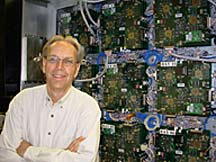 |
|
Alan
Russell
|
You'll find gold, silver and bronze in Alan Russell's office,
but not because the Ames Laboratory
metallurgist is conducting research on precious metals. These
medallions represent Russell's athletic prowess as a nationally
ranked master's decathlete and pentathlete.
For a number of years, Russell has been at or near the top
of the USA Track and Field National Master's Outdoor Decathlon
Championships, winning the event in 1997, 2000, 2001, and last
year and placing fourth this summer in the 50-54 age group.
The decathlon is comprised of the 100-meter dash, long jump,
shot put, high jump, 400-meter dash, 110-meter high hurdles,
discus, pole vault, javelin throw, and 1500-meter run with points
awarded based on place and time/distance/height cleared.
Oddly enough, Russell turned to the track as an outlet after
deciding that his favorite pursuit of mountain climbing was
too dangerous for the father of three small children.
"I got into climbing when I worked at Los
Alamos," Russell said, "and climbed all over the western
hemisphere—Alaska, Baffin Island, Peru and Argentina."
An avalanche during a climb on Aconcagua in the Argentinian
Andes convinced him to hang up the ice axe.
After success running the 200m and 400m in the annual Iowa
Games, he moved up to the national level, but found he wasn't
built to race at that level.
"I could make it into the finals, but didn't have much hope
of winning," Russell said, "so a friend suggested I try the
multi-events. It's daunting to take up pole vaulting and discus
in your mid-40's, but the Iowa
State track athletes have graciously given the old professor
some pointers and it's turned out pretty well."
The variety of training required is what keeps him coming back,
and helps keep him refreshed in both the laboratory and classroom.
"I really value that change of pace," he said. "I'm just sharper
mentally if I can work out."
Submitted by DOE's Ames Laboratory
|
|






